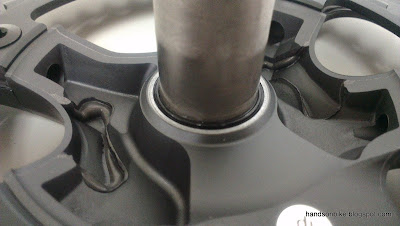Looking to get a brand new crankset for your road bike? Can't decide if you should go for the top of the range Dura-Ace, or the second grade Ultegra? In this post, I will compare these two cranksets in detail, and you can decide for yourself whether the differences are worth saving up for.
I recently upgraded the crankset on the Merida Scultura 5000 road bike from Ultegra 6800 to Dura-Ace 9000, and I took the chance to compare these two cranksets. Here are the details!
After comparing the appearance of the crankset, we can move on to compare the weight of the cranksets. With the same chainring sizes and also the same crank arm lengths, it will give an accurate weight comparison.
After using both of these cranksets for a few months each, my conclusion is that there is no difference in performance. Both of them shift very well, and are also very stiff for optimal power transfer. The only factor affecting your choice should be the price (Ultegra is half the price of Dura-Ace), the weight (Dura-Ace is 60 grams lighter), or the appearance (personal preference).
The value choice would be Ultegra, as it is more affordable, and the dark grey appearance matches most bike frames. The extra 60 grams of weight is probably not significant at all. If I were to choose, the Ultegra crankset is my choice. Of course, if your budget allows, go ahead and get the Dura-Ace crankset if that is your preference!
I recently upgraded the crankset on the Merida Scultura 5000 road bike from Ultegra 6800 to Dura-Ace 9000, and I took the chance to compare these two cranksets. Here are the details!
Ultegra 6800 50/34T Compact Crankset, 170mm length
Dura-Ace 9000 50/34T Compact Crankset, 170mm length
11 speed chainring on the Ultegra crankset, 50/34T
Same chainring size on the Dura-Ace crankset, with a unique two-tone anodising surface treatment
Chain pick up pins and ramps can be found on the composite shell bonded to the back of the Ultegra Hollowglide chainring
Cleaner looking pick up ramps and pins on the Dura-Ace chainring. The design looks deceptively simple but it shifts really well. There is a lot of know-how regarding the placement, shape, angle and height of the pins, and also the individual teeth shape.
Ultegra 34T inner chainring, with the specs stamped onto the aluminium chainring
Laser marked 34T indication on the Dura-Ace inner chainring, with a grooved cutout to save weight
The Ultegra crank arm is 170mm in length
Same 170mm length for the Dura-Ace crank arm
Slightly different crank arm shape, with rounded edges on the Ultegra crank arm, while the Dura-Ace crank arm looks slightly wider and edgier. The glossy finish on the Dura-Ace crank arm is also more prone to fingerprint or grease marks.
Rounded edges on the Ultegra crank arm, while the Dura-Ace crank arm has sharper edges.
Here is where the difference is more obvious. The rear of the Ultegra crank arm is an open hollow shell, with the 4-arm rear layer glued to the front piece with epoxy, as can be seen here.
The Dura-Ace crank arm looks more well refined, with a closed hollow crankarm, cleanly bonded without any excess epoxy visible.
After comparing the appearance of the crankset, we can move on to compare the weight of the cranksets. With the same chainring sizes and also the same crank arm lengths, it will give an accurate weight comparison.
Left Ultegra 6800 170mm crank arm with crank arm fixing bolt, 197 grams.
Left Dura-Ace 9000 170mm crank arm with crank arm fixing bolt, 176 grams. About 20 grams lighter.
Right Ultegra 6800 170mm crank arm with 50/34T chainrings, 480 grams
Right Dura-Ace 9000 170mm crank arm with 50/34T chainrings, 440 grams. 40 grams lighter.
Weight of Ultegra 6800 50/34T crankset is 677 grams. A very good weight for an aluminum 2x11 speed crankset.
Dura-Ace 9000 50/34T crankset is only 615 grams, pushing the limits on aluminium cold forging technology!
View of the rear of the cranksets, showing the differences in the crank arms and the chainrings
Overall view of the Ultegra 6800 and Dura-Ace 9000 cranksets side by side
After using both of these cranksets for a few months each, my conclusion is that there is no difference in performance. Both of them shift very well, and are also very stiff for optimal power transfer. The only factor affecting your choice should be the price (Ultegra is half the price of Dura-Ace), the weight (Dura-Ace is 60 grams lighter), or the appearance (personal preference).
The value choice would be Ultegra, as it is more affordable, and the dark grey appearance matches most bike frames. The extra 60 grams of weight is probably not significant at all. If I were to choose, the Ultegra crankset is my choice. Of course, if your budget allows, go ahead and get the Dura-Ace crankset if that is your preference!




















